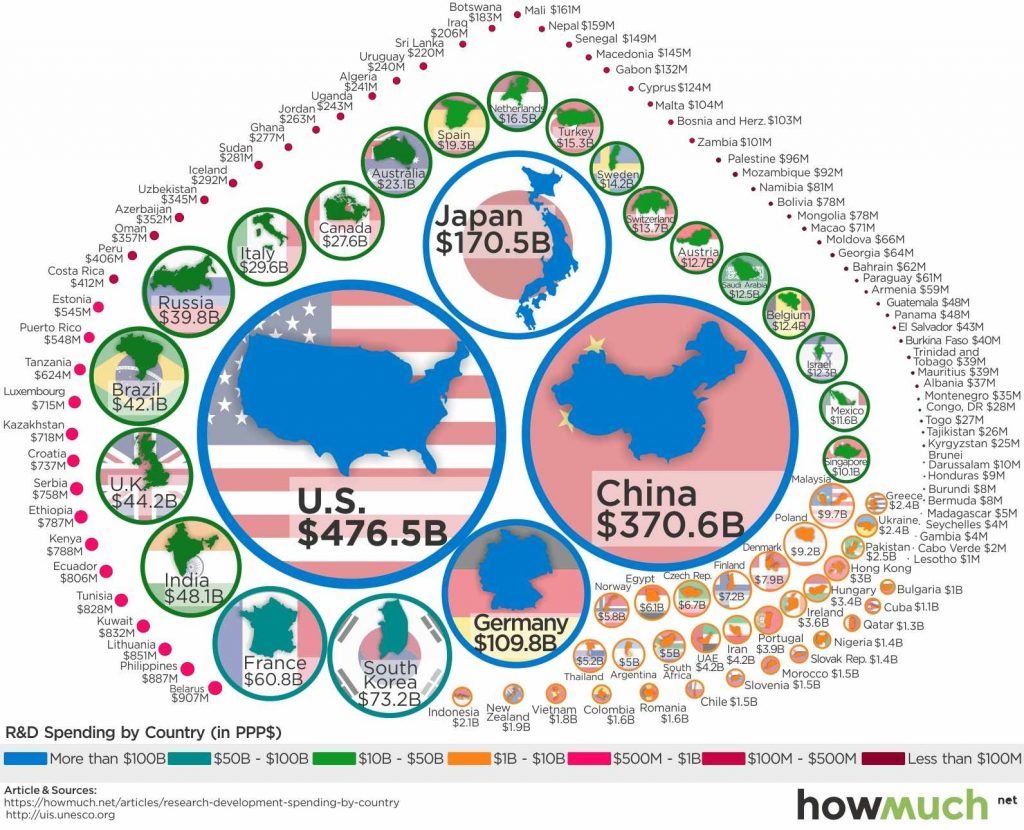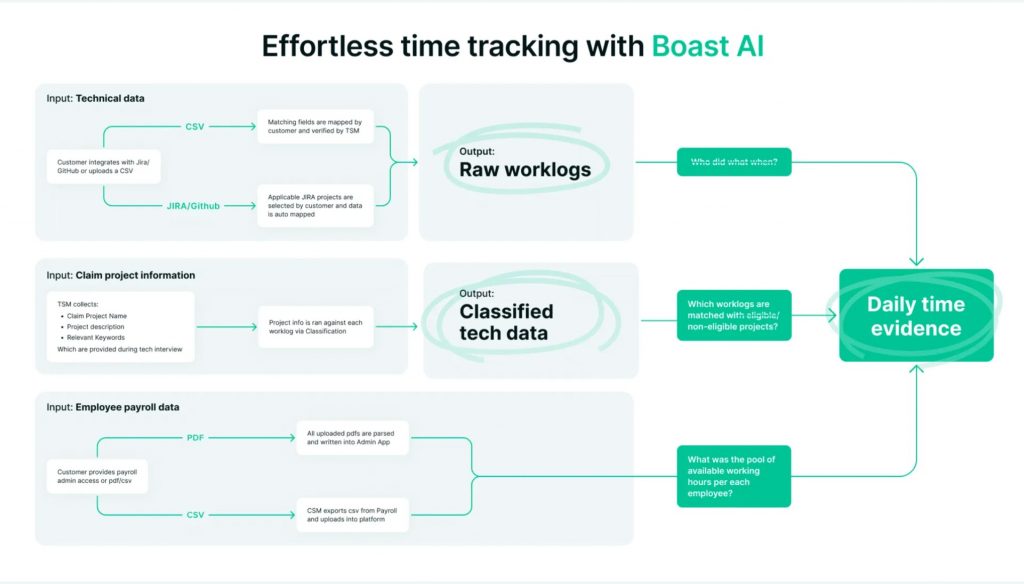In today’s ever-evolving global business landscape, innovation is the key for US companies to stay ahead of the curve. However, the research and development (R&D) required to drive innovation poses a significant financial and adminstrative burden for companies of all sizes. In 2022 US R&D investment grew 12% YoY to $885 billion (current dollars) with investment from business increasing 14% to $692 billion. Fortunately, the United States government recognizes the importance of fostering a culture of innovation to drive productivity economic growth, and global competitiveness. As such it has put into place lucrative tax incentives to support businesses engaged in qualifying R&D activities. In this blog post, we dive into the US R&D Tax Credit and its importance in providing much-needed capital for start-ups in key economic sectors. It is one of the most significant tax credits under US law. We’ll also take a look at Boast.ai and its recently released Time Evidence Engine developed to help companies better prepare and successfully claim R&D tax credits, unlock tax savings, and further spur innovation across American industries.
What is the R&D Tax Credit?
The R&D tax credit is a dollar-for-dollar reduction in a company’s federal income tax liability, providing a valuable financial boost to organizations investing in the development of new or improved products, processes, or technologies. Initially introduced in the Economic Recovery Tax Act of 1981, the R&D tax credit has undergone several iterations and expansions, making it an increasingly attractive opportunity for businesses across a wide range of industries. This credit aims to stimulate innovation, encourage investment in development in the US, and is available across numerous industries. Companies can claim this credit by investing in activities recognized by the IRS as R&D, regardless of industry, and it can lead to significant tax savings by reducing federal and state income tax liability, improving cash flow, and offering other financial benefits. Since its inception until today, it has remained one of the most consequential tax credits under US tax law. In 2022 over 14,000 businesses applied for the R&D Tax credit. However, despite its benefits, roughly 3 in 10 companies apply for credit, suggesting lost opportunities to provide much-needed capital for start-ups in their product development cycle.
R&D Spending in the United States
According to the latest data from the National Science Foundation, businesses in the United States spent a staggering $587 billion on research and development in 2022 (Constant Dollars 2017). This figure represents a 23% increase from the $478.9 billion spent on R&D in 2019. In total, over $750 billion was invested into research and development activities underscoring the essential nature of innovation to the United States economy.
Ranking of R&D Spending by Country
The United States remains the leader in investment in R&D experiencing growth in R&D funding nearly every year since 1955 although countries such as China, Germany, and Japan also invest heavily in R&D. However, the US R&D to GDP ratio was estimated at 3.44% well above OECD (2.72%), China (2.43%) and the UK (2.91%) Underpinning the strength of investment in R&D in the United States is the breadth and depth of its academic institutions. Across US economic clusters or megaregions, the East and West coasts remain key centers for academic research with institutions such as MIT, Stanford, Harvard, and Caltech leading in fields such as biotechnology and artificial intelligence. Recent government spending from the CHIPS and Science Act, ongoing geopolitical risks, and supply chain shifts toward friendshoring and nearshoring suggest growth in R&D investment to continue to the foreseeable future.
The sectors that spend the most on R&D include.
- Manufacturing: $326 billion in R&D spending
- Information (including tech): $148 billion
- Pharmaceuticals $101 billion
- Professional, Scientific, and Technical Services: $70.9 billion
- Aerospace and Defense: $9.4 billion
These numbers highlight the critical role that R&D plays in maintaining the competitiveness and technological edge of American businesses, making the R&D tax credit all the more valuable for companies operating in these sectors.
Eligible Industries for the R&D Tax Credit
The R&D tax credit is not limited to any one sector – it is available to companies engaged in qualifying research activities within a diverse array of industries. Generally,, qualifying criteria for the R&D tax credit include activities that involve the development or improvement of an existing product, process, technique, formula, invention, or software. Key sectors claiming the R&D tax credit include:
- Software Development
- Gaming, Virtual Reality & Augmented Reality
- Information Technology
- Architecture & Engineering
- Biotech & Pharmaceuticals
- Food & Beverage Manufacturing
- Industrial & Automotive Design
- Medical Devices & Equipment
- Cloud Computing
The list of industries eligible for the R&D tax credit goes on, encompassing sectors as diverse as agriculture, energy, telecommunications, and even creative industries Regardless of the industry, if a company is engaged in qualifying research and development, it is likely eligible to claim valuable tax credits.
Challenges in Claiming R&D Tax Credits
Despite its apparent benefits, claiming R&D tax credits can be a complex and challenging process for many businesses. The major bottlenecks include:
- Proper documentation and substantiating the qualified research activities and expenses. The process is very administrative with companies required to produce invoices, contracts, timesheets, payroll taxes, and records among other necessary documentation.
- Identifying all potentially qualifying projects and expenses, as definitions can be somewhat ambiguous. Companies are required to submit business plans or other evidence supporting the qualifying R&D activity. For example, expenses can include salaries, US subcontractors, patents, IT infrastructure, etc.
- Filing the correct forms and meeting deadlines, can also pose difficulties for businesses, especially smaller organizations with limited tax and accounting resources
- Developing an effective 360 planning process and staying compliant.
The Benefits of Working with Boast.ai
Navigating the complexities of the R&D tax credit can be a daunting task for many businesses, especially smaller organizations with limited resources. While there is no deadline to submit your R&D tax credit claim, the credit can only be applied to the qualified research expenditures in the current or previous year. As such time is of the essence. This is where firms like Boast.ai come into play.
Boast.ai is a leading provider of R&D tax credit services, helping companies of all sizes maximize their eligible credits and optimize their tax savings. With a team of experienced tax and financial professionals, Boast.ai guides clients through the entire R&D tax credit process, from identifying qualifying activities to preparing and filing the necessary documentation. In a nutshell, the company automates the entire R&D tax credit claim process. Since its inception in 2011, Boast has helped over 1200 companies claim more than $4 billion in R&D tax credits with each company saving over 60 hours each year.
Boast.ai offers a series of solutions including AI powers software to automate the R&D tax credit claims process. For starters, the company maintains an in-house set of technical and financial R&D experts. Its dashboard can motor time tracking, cash spending, audit evidence, and tax forms. More importantly, the Boast.ai platform can integrate with hundreds of other systems to extract the relevant data necessary for the claims process.
Boast.ai also allows companies to access their advanced refunds in under two weeks to gain access to non-dilutive capital to further scale their business. However, this is currently only available with SR&ED refunds in the Canadian market.
The Boast Time Evidence Engine
One of the innovative features recently launched is the Boast Time Evidence Engine (BTEE). The BTEE addresses a key bottleneck in the R&D credit lams process- that is telling the story behind the innovation. In the innovation process capturing and understanding each member’s contributions and time can be a daunting process. The BTEE enables customers to track, document, and validate the contribution and time spent by all stakeholders involved in R&D projects. Key benefits of the BTEE include:
Boast Time Evidence Engine Model
- Seamless Integration: BTEE connects directly with Jira/Github or any preferred project management tools through export/import, ensuring a smooth data flow from your preferred tools into our platform.
- Detailed Worklogs: Automatically generated worklogs offer granular insights into the contributions of each team member, detailing the who, what, and when of project involvement.
- Expert Classification: Our in-house experts meticulously classify worklogs to identify projects and activities eligible for specific benefits, ensuring that every qualifying effort is accurately accounted for.
- Accurate Time Allocation: Incorporating payroll data, our system precisely calculates the available working hours of each employee, providing a solid foundation for exact project time evidence.
The BTEE eliminates the need for manual entry and tracking, bringing a remarkable level of clarity to the R&D project development process. This reduces the time and increases the probability of a successful R&D tax credit claim. By leveraging Boast.ai’s expertise, technology, and performance-based model, companies can unlock significant tax savings and reinvest those funds back into their core business operations, fueling further innovation and growth.
SME Growth Tools From ClearSky 2100 Ventures
Boast.ai’s services fit with companies with technical teams of four or more. Attractive sectors include cleantech, climate tech, software development, biotech, and manufacturing among others. Boast.ai forms part of the portfolio of growth tools provided by ClearSky 2100 Ventures partnerships for growth. Other solutions benefiting companies across their R&D journey include Fristbase.io (US company formation), Deel (US contractor workforce management), ContactOut (global lead generation) and Lucidspark (real-time virtual collaboration tools), and Hiver, (operations management suite for Google Workspace).
The Wave of Innovation Continues
Finally, The R&D tax credit represents a significant opportunity for businesses across a wide range of industries to offset the substantial costs of their research and development efforts. By taking advantage of this tax incentive, companies not only improve their bottom line but also fuel the continuous innovation that is essential for long-term success in today’s highly competitive global market. Longer-term societal challenges such as climate, food and water security, artificial intelligence, geopolitical conflict, healthcare, etc., will require significant spending in R&D to solve these challenges.
For businesses looking to maximize their R&D tax credit benefits, partnering with a specialized firm like Boast.ai can be a game-changer. Boast.ai’s team of in-house experts, cutting-edge technology, and performance-based models ensure that clients receive the maximum financial return on their investment in research and development. By harnessing the power of the R&D tax credit through a collaboration with Boast.ai, companies can unlock their full innovative potential and contribute to the broader economic progress and the innovation leadership of the United States.
To learn more about Boast.ai reach out to the team at ClearSky 2100. To get started with Boast.ai following the link here and begin your journey to efficiency, growth and value creation.
Disclosure: At ClearSky 2100, our portfolio partly consists of affiliate partnerships. We may earn a small commission from buying links on our site at no cost to you.










